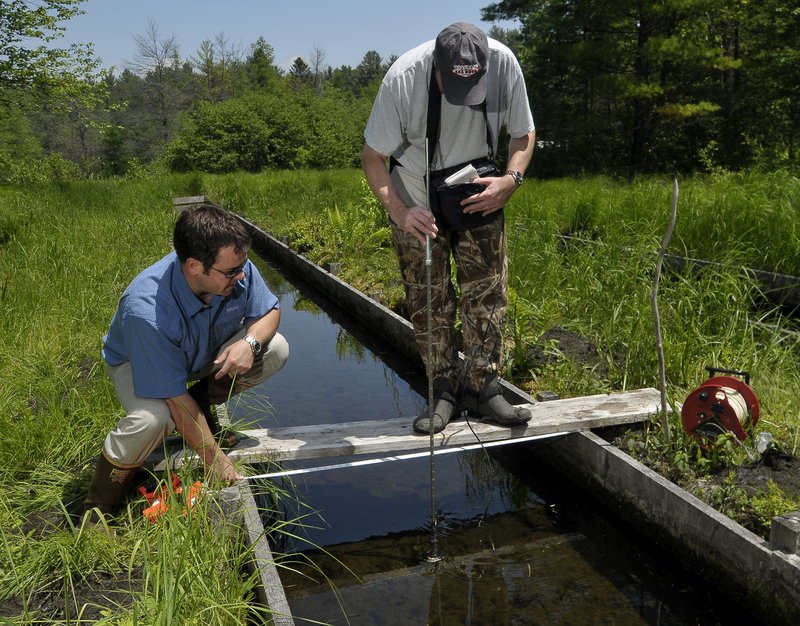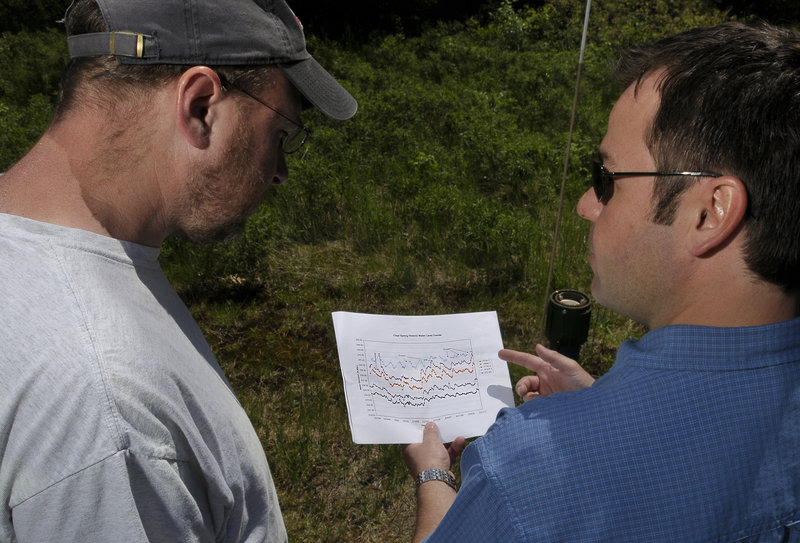HOLLIS — It was not what I pictured a geologist doing.
About an hour into my time with Mark Dubois, a geologist for the Poland Spring water company, I was balancing on a wobbly board that straddled an old canal near a fish hatchery.
Strapped around my neck was a $3,000 portable water flow meter — the Marsh-McBirney Flo Tote — and in my right hand was a long metal rod, with measurements etched along its length, that was wired into the flow meter.
My goal, Dubois told me, was to position the rod so that it was just barely touching the canal’s bottom, then turn on the flow meter and get a measurement. Then write it down. Then repeat every few inches, all the way across this 4-foot-wide canal.
And try not to fall in.
“You don’t want to step right on the end of this board,” said Dubois, after I had done just that and almost landed in the drink. “You want to make your last step where the board touches ground.”
I had thought that, as a geologist, Dubois would be spelunking his way through underground caves to get to the magical source of Poland Spring’s water. But what Dubois does, and what I helped with, is monitor water — in the ground, in streams, in ponds — across the 1,500 acres surrounding the company’s spring site in Hollis.
Dubois doesn’t check for drinking water quality. That’s done later, in the bottling process.
Dubois’ job is to check wells, streams and other sources to make sure the water that Poland Spring is taking out of the ground is being replenished at proper and sustainable rates.
Some people believe that Poland Spring can’t help but disrupt the natural state of water in an area by taking it out of the ground. Dubois says he works to prevent that from happening.
“We basically monitor in three areas, to get a picture of the total cycle,” he told me, just after swatting a massive deer fly off his arm. “We measure precipitation, the water coming in, we measure the recharge rate of the groundwater, how long it takes for levels to get back to where they were, and we measure the out-of-spring flow, the amount of water that leaves here and, in this case, flows down to Saco.”
He told me that the monitoring work done at the Hollis site shows that water levels have actually gone up, not down, over the past few years.
Dubois is part of a team of geologists doing that work, and he does it at all of Poland Spring’s nine spring sites in Maine, stretching from Hollis in York County to Spruce Spring, north of Kingfield.
Dubois says it takes about two days in the field each month to check all the various measuring points on the Hollis property. Among the things he measures is the depth of 75 monitoring wells on the property, as well as “bore holes,” from which the water is drawn.
He also checks the levels of about 10 privately owned wells near the property to make sure they’re not being depleted. Then he goes through the woods to various streams and bodies of water to check their levels and flows.
He did that on the day I was with him, by driving his pickup truck over dirt roads into the woods on the Hollis site, then getting out and lugging his scientific equipment through streams, mud and insects to get to where he needed to take measurements.
When I first ventured into the woods with Dubois, he made me tuck my pants into my socks, to prevent ticks on the ground from crawling up. Then I sprayed myself with bug spray, and later I donned hip waders.
Then we trudged over a very muddy trail through waist-high grass, often having to balance over a series of wobbly boards to avoid stepping in the many tributary waterways.
We carried a giant spool of measuring tape, the flow meter, the flow rod and other gadgets along the way.
At some point we encountered deer flies, giant bugs with camouflage wings, that Dubois says have taken a pound or more of his flesh over the years. Later in the day, while we were driving out of the woods, Dubois picked two ticks off his neck.
Not being an outdoorsman, I wasn’t sure I could spot a tick on me. Dubois comforted me by saying that on my drive back to Portland, I should blast the air conditioning.
“If it gets real cold, you’ll feel them start to move,” he told me.
Oh, good.
On the way to the canals, Dubois told me that the bore holes go down through the sand and soil at the surface, down to the store of groundwater at a spring point. A spring, Dubois told me, is generally defined as a place where the groundwater meets the surface. So it’s not standing water, like in a pond.
The sand and other material have a lot to do with the water’s taste, Dubois told me. In fact, Poland Spring chooses sites with soil conditions and minerals similar to the original spring in the town of Poland, so the water will have a similar taste.
“See how light the sand is here,” said Dubois, who has a master’s degree in geology. “Up in a place like Madison, it’s a lot darker, and we would not use springs up there. When you look at regional (brands of bottled water) they all taste different, because the minerals and conditions are so different.”
So I guess one thing I learned is that Poland Spring really does, in a very literal sense, taste like Maine.
Staff Writer Ray Routhier can be contacted at 791-6454 or at:
rrouthier@pressherald.com
Send questions/comments to the editors.




